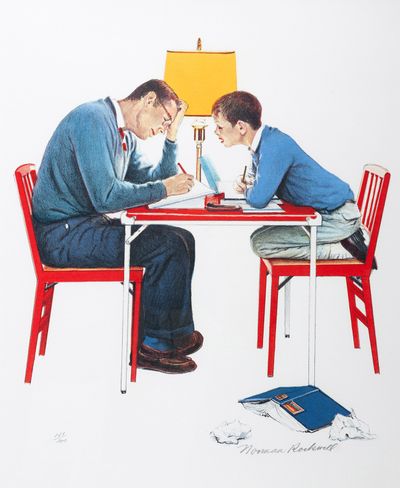Sale of Norman Rockwell lithographs will benefit students

The Depression was on and Walter Powers was 9, delivering copies of the Saturday Evening Post to make money to buy his clothes, when he saw himself on the covers.
It wasn’t Powers exactly whom Norman Rockwell depicted in his illustrations, but American boys whom Powers, growing up in Waco, Texas, found to be highly relatable.
“It was so realistic,” said Powers, now 90. “I just could see myself in so many of these pictures.”
Some 80 years later, Powers and his wife, Myrtle Powers, are adding to their legacy as educators through the sale of nearly two dozen signed lithographs of Rockwell’s work – pieces they collected together starting in the 1960s not as investments, but because they both saw in them a reality they could relate to.
In all, 23 prints the Powerses donated to Eastern Washington University will be sold starting tonight to raise scholarship money for students studying school or mental health counseling at the university. Walt Powers taught counseling students at EWU for 43 years. Myrtle Powers, now 93, taught elementary students for more than 20 years in Cheney after stints in other districts.
The Cheney couple spotted their first signed lithograph – a special print created under the artist’s supervision – of Rockwell’s “Spelling Bee” in a Seattle gallery. They both remembered the piece from childhood – they could see themselves in its line of schoolchildren, all eyes focused on the girl in the middle whose turn to spell had come.
When they bought that illustration for around $200, they didn’t know it was the start of a collection of Rockwell’s lithographs – they’d stop at 57 – that would become recognized as one of the nation’s largest, touring from museum to museum for about seven years.
Sale organizers hope to raise $25,000 to $30,000, with Dodson’s Jewelers – where the pieces are on display – acting as a commission-free sales agent, said Laura Thayer, an EWU donor relations coordinator.
The Powerses kept their collection at home, and Walter Powers invited students into his home to see it at the ends of semesters. He remembered only one art class coming to see the collection – considered “just an illustrator,” Rockwell wasn’t popular with EWU’s art department, Powers said.
Many critics have dismissed Rockwell’s work as cliched or simplistic.
But some reports – and recent sales – suggest a new respect for Rockwell’s work.
The New York Times ran an article headlined “Norman Rockwell’s Art, Once Sniffed At, Is Becoming Prized” in May 2014, shortly after his “After the Prom” sold for $9.1 million and “The Rookie” for $22.5 million.
A Vanity Fair article about two earlier Rockwell shows, in 2009, claimed “America is rediscovering one of its most underappreciated and misunderstood artists.”
Thayer said other factors contributed to the timing of the sale, not any perceived new interest in Rockwell’s work.
The sale offers a chance for people who can’t afford Rockwell’s paintings to buy his work, she said. The lithographs are reinterpretations of some of Rockwell’s earlier paintings and drawings, Thayer said, created in limited editions of 200.
“They’re handmade prints,” she said. “They’re considered original works of art.”